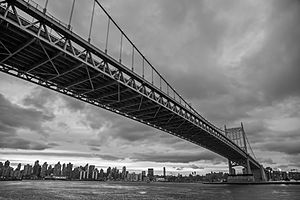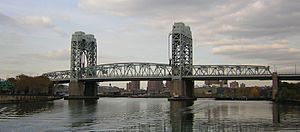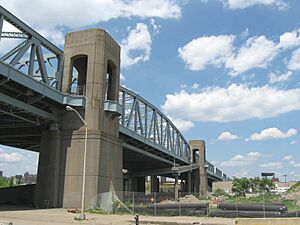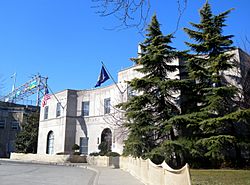Robert F. Kennedy Bridge facts for kids
Quick facts for kids Robert F. Kennedy Bridge(Triborough Bridge) |
|
|---|---|
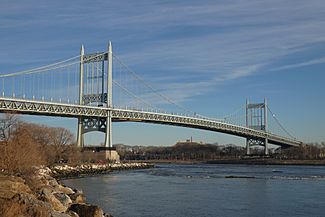
|
|
| Coordinates | 40°46′50″N 73°55′39″W / 40.78056°N 73.92750°W |
| Carries | 8 lanes of Invalid type: I-Toll (Bronx and Queens spans) 6 lanes of NY 900G (Manhattan span) |
| Crosses | East River, Harlem River and Bronx Kill |
| Locale | New York City, United States |
| Official name | Robert F. Kennedy Bridge |
| Other name(s) | RFK Triborough Bridge, Triboro Bridge, RFK Bridge |
| Maintained by | MTA Bridges and Tunnels |
| Characteristics | |
| Design | Suspension bridge, lift bridge, truss bridge |
| Total length | 2,780 feet (850 m) (Queens span) 770 feet (230 m) (Manhattan span) 1,600 feet (490 m) (Bronx span) |
| Width | 98 feet (30 m) (Queens span) |
| Longest span | 1,380 feet (420 m) (Queens span) 310 feet (94 m) (Manhattan span) 383 feet (117 m) (Bronx span) |
| Clearance above | 14 feet 6 inches (4.42 m) (Queens/Bronx spans) 13 feet 10 inches (4.22 m) (Manhattan span) |
| Clearance below | 143 feet (44 m) (Queens span) 135 feet (41 m) (Manhattan span when raised) 55 feet (17 m) (Bronx span) |
| History | |
| Construction cost | $60,300,000 |
| Opened | July 11, 1936 |
| Statistics | |
| Daily traffic | 95,552 (Queens–Manhattan and Bronx–Manhattan, 2016) 83,053 (Queens–Bronx, 2016) |
| Toll | As of April 11, 2021, $10.17 (Tolls By Mail and non-New York E-ZPass); $6.55 (New York E-ZPass); $8.36 (Mid-Tier NYCSC E-Z Pass) |
The Robert F. Kennedy Bridge (often called the RFK Bridge or its old name, the Triborough Bridge) is a huge set of bridges and elevated roads in New York City. It connects three of New York City's main areas, called boroughs: Manhattan, Queens, and the Bronx. These roads also cross Randalls and Wards Islands, which used to be two separate islands but are now joined together.
The RFK Bridge is a toll bridge, meaning you have to pay to cross it. It carries Interstate 278 (I-278) and another road called New York State Route 900G. The bridge connects to many important highways in New York City, like the FDR Drive in Manhattan and the Bruckner Expressway in the Bronx.
The RFK Bridge complex has three main bridges:
- A vertical-lift bridge over the Harlem River, which connects Manhattan Island to Randalls Island. This was the largest lift bridge in the world when it was built.
- A truss bridge over Bronx Kill, which connects Randalls Island to the Bronx.
- A suspension bridge over Hell Gate (a narrow part of the East River), which connects Wards Island to Astoria in Queens.
These three bridges are linked by an elevated highway that crosses Randalls and Wards Islands. There are also many support roads. The bridge complex was designed by Allston Dana, with help from Othmar Ammann and architect Aymar Embury II. It was so big that it was called "not a bridge so much as a traffic machine." The American Society of Civil Engineers named it a National Historic Civil Engineering Landmark in 1986. The bridge is owned and run by MTA Bridges and Tunnels.
Contents
What is the RFK Bridge like?
The RFK Bridge has four main parts. The three main bridge sections cross the East River to Queens, the Harlem River to Manhattan, and Bronx Kill to the Bronx. The fourth part is a T-shaped elevated road that leads to a central meeting point on Randalls Island.
The bridge complex is about 17.5 miles (28.2 km) long in total, including all the elevated ramps. The main designers were chief engineer Othmar H. Ammann and architect Aymar Embury II.
East River Suspension Bridge (I-278)
The East River span is a suspension bridge that crosses the Hell Gate part of the East River. It connects Queens with Wards Island. This part of the bridge has eight lanes for cars, four in each direction, and a sidewalk on one side. It connects to the Grand Central Parkway in Astoria, Queens.
This suspension bridge was designed by Othmar Ammann. It was first planned to have two levels with eight lanes on each, but this was changed to a single level with eight lanes to save money. The middle part of the bridge between the two tall towers is 1,380 feet (421 m) long. The total length of this bridge section is 2,780 feet (847 m).
The bridge towers are 315 feet (96 m) tall. There is 143 feet (44 m) of space under the middle of the bridge for boats to pass. The towers have a simple design with cross bracing and Art Deco style tops.
The bridge is held up by two main cables, which are supported by the towers. Each cable is 20 inches (51 cm) thick and contains 10,800 miles (17,400 km) of individual wires! These cables are anchored into huge blocks of concrete at both ends of the bridge.
Harlem River Lift Bridge (NY 900G)
The Harlem River span is a lift bridge. This means a section of the bridge can be raised to let tall boats pass underneath. It connects Manhattan with Randalls Island and was also designed by Othmar Ammann. This part of the bridge has six lanes for cars and two sidewalks. It connects to the Harlem River Drive and the FDR Drive in East Harlem, Manhattan.
When it was finished, this lift bridge had the largest deck (the part cars drive on) of any lift bridge in the world. The movable part of the bridge is 310 feet (94 m) long. The total length of this bridge section is 700 feet (213 m).
When the bridge is closed, it is 55 feet (17 m) above the water. But it can be raised up to 135 feet (41 m) high! The movable section is lifted by 96 wire ropes that go around large pulleys.
Bronx Kill Crossing (I-278)
The Bronx Kill span is a truss bridge that connects the Bronx with Randalls Island. It carries eight lanes of I-278 and two sidewalks. This bridge connects to the Major Deegan Expressway (I-87) and the Bruckner Expressway (I-278) in Mott Haven, Bronx.
This part of the bridge has three main sections that do not move, because the Bronx Kill waterway is not used by many boats. The main part of the bridge is 383 feet (117 m) long. The total length of this bridge section is 1,600 feet (488 m). It is 55 feet (17 m) above the water.
Interchange Plaza and Approach Roads
The three main bridge sections of the RFK Bridge all meet at a special intersection on Randalls Island. This intersection is designed so that roads cross over or under each other, preventing traffic jams.
This area used to have two tollbooths where drivers would pay. But in 2017, the MTA (the company that runs the bridge) started collecting all tolls electronically. This means cameras read your license plate or E-ZPass, and you don't have to stop at a booth anymore. The old tollbooths were then removed.
The Robert Moses Administration Building, an Art Deco style building, used to be the main office for the bridge authority. It was located near the Manhattan span's toll plaza.
The roads connecting the bridge sections are elevated, meaning they are built high up on supports. These elevated roads are mostly eight lanes wide. They used to cross a small creek called Little Hell Gate, which separated Randalls and Wards Islands, but that waterway has since been filled in.
Building the RFK Bridge
Early Ideas
The idea for a bridge connecting Manhattan, Queens, and the Bronx first came up in 1916. People called it the "Tri-Borough Bridge." It was planned to connect 125th Street in Manhattan, St. Ann's Avenue in the Bronx, and a spot in Queens. This new bridge would be built near the Hell Gate Bridge, which was a railroad bridge.
Some people, like Gustav Lindenthal who designed the Hell Gate Bridge, thought a new bridge wasn't needed. They suggested adding a car deck to the existing Hell Gate Bridge. But others wanted a completely new bridge.
Getting the Money
The Tri-Borough Bridge project finally got some money in June 1925 for planning and testing the ground. However, the Great Depression hit in 1929, making it very hard for New York City to pay for big projects. Construction almost stopped completely.
In 1932, Senator Robert F. Wagner tried to get a large loan from the federal government to build the bridge. But the mayor at the time, Joseph V. McKee, didn't want federal help.
Then, in 1933, a special group led by Robert Moses asked for a big loan from the federal government. They also got permission to create the Triborough Bridge Authority (TBA). This new group could sell bonds (like loans from investors) and use tolls from the bridge to pay for its construction. The federal government agreed to provide a large loan and a subsidy, which helped the project move forward.
Construction Begins (Again!)
Construction on the Triborough Bridge started again in November 1933. Many apartment buildings had to be torn down to make way for the bridge and its approach roads. Hospital buildings on Randalls and Wards Islands also had to be moved.
To save money, the original plan for the Queens span was changed from a 16-lane, double-deck road to an 8-lane, single-deck road. The design of the suspension towers was also made simpler.
Robert Moses became the chairman of the TBA in April 1934. He worked very hard to speed up the project and connect the bridge to a new system of highways and parks around New York City. For example, the Grand Central Parkway was extended to meet the bridge in Queens. The Bronx Kill span was also changed to a fixed truss bridge instead of a lift bridge, as the waterway wasn't used much by boats.
By February 1935, the towers for the East River suspension bridge were almost done. The main suspension cables for the Queens span were finished in July 1935. The bridge was expected to open in 1936, just in time for the 1939 New York World's Fair in Queens.
One interesting fact: there was a debate about using steel from Nazi Germany for the bridge because it was cheaper. But Mayor Fiorello H. La Guardia stopped the deal, saying New York didn't want anything from "Hitlerland."
In April 1936, the huge movable part of the Harlem River lift bridge was floated into place. The 200-ton section was lifted into position in just sixteen minutes!
Parks and playgrounds were also built under the bridges and roads, including Randall's Island Park and Downing Stadium.
Opening Day
The completed bridge, which was called a "Y-shaped sky highway," was officially opened on July 11, 1936. The ceremony was held at the central meeting point on Randalls Island. Important people like President Roosevelt, Mayor La Guardia, and Governor Lehman gave speeches. Robert Moses was the master of ceremonies.
The bridge opened to the public at 1:30 p.m. that day. By midnight, about 200,000 people had visited the bridge by car, bus, or on foot! On its first full day, 40,000 vehicles used the bridge. The American Institute of Steel Construction later said the Triborough Bridge was the most beautiful steel bridge built in 1936.
The Triborough Bridge cost about $60.3 million, which was a huge amount of money at the time. It was one of the biggest public works projects during the Great Depression.
Later Years and Renaming
After the bridge opened, more highways were built to connect to it, like the Brooklyn-Queens Expressway and the Major Deegan Expressway. These roads helped cars move smoothly through the New York City area.
In 1968, the Triborough Bridge had its first major update. More tollbooths were added, and some ramps were made wider. In 1997, a big project called the Triborough Bridge Rehabilitation Project began to fix and improve different parts of the bridge.
On November 19, 2008, the Triborough Bridge was officially renamed the Robert F. Kennedy Bridge. This was done to honor Robert F. Kennedy, a former U.S. Senator and Attorney General, who was assassinated 40 years earlier. Many people still call it the "Triborough Bridge" or the "RFK Triborough Bridge" to avoid confusion.
More renovations continued in the 2010s, including rebuilding roadways and ramps. On June 15, 2017, the bridge started using cashless tolling. This means drivers no longer stop at tollbooths. Instead, cameras overhead read E-ZPass transponders or take pictures of license plates to send bills by mail. The old tollbooths were then taken down.
How the Bridge is Used
The money collected from tolls on the RFK Bridge helps pay for public transportation in New York City, like the subway and commuter trains. In 2014, about 164,116 vehicles used the bridge each day.
Walking and Biking
The bridge has sidewalks on all three of its sections. Officially, bicyclists are supposed to walk their bikes across for safety reasons, but many don't. The Queens span's sidewalk has stairs, which makes it hard for people with disabilities to use.
Public Transportation
Several bus routes operated by MTA New York City Transit use the RFK Bridge. These include the M35, M60 SBS, X80 routes, and several express bus routes like BxM6, BxM7, BxM8, BxM9, BxM10, BxM11. These buses connect Manhattan, Queens, and the Bronx.
Long ago, in the 1920s, there was even a plan to extend the New York City Subway's BMT Astoria Line across the Triborough Bridge!
Tolls
As of August 6, 2023, drivers pay $11.19 per car for tolls by mail or if they use an E-ZPass not from New York. If you have a New York E-ZPass, it costs $6.94 per car. There are also different rates for motorcycles.
When the Triborough Bridge first opened, it had 22 tollbooths. In 1996, drivers could start paying with E-ZPass. As mentioned, since June 15, 2017, all tolls are collected electronically, so you don't stop at a booth anymore.
See also
 In Spanish: Puente Robert F. Kennedy para niños
In Spanish: Puente Robert F. Kennedy para niños


